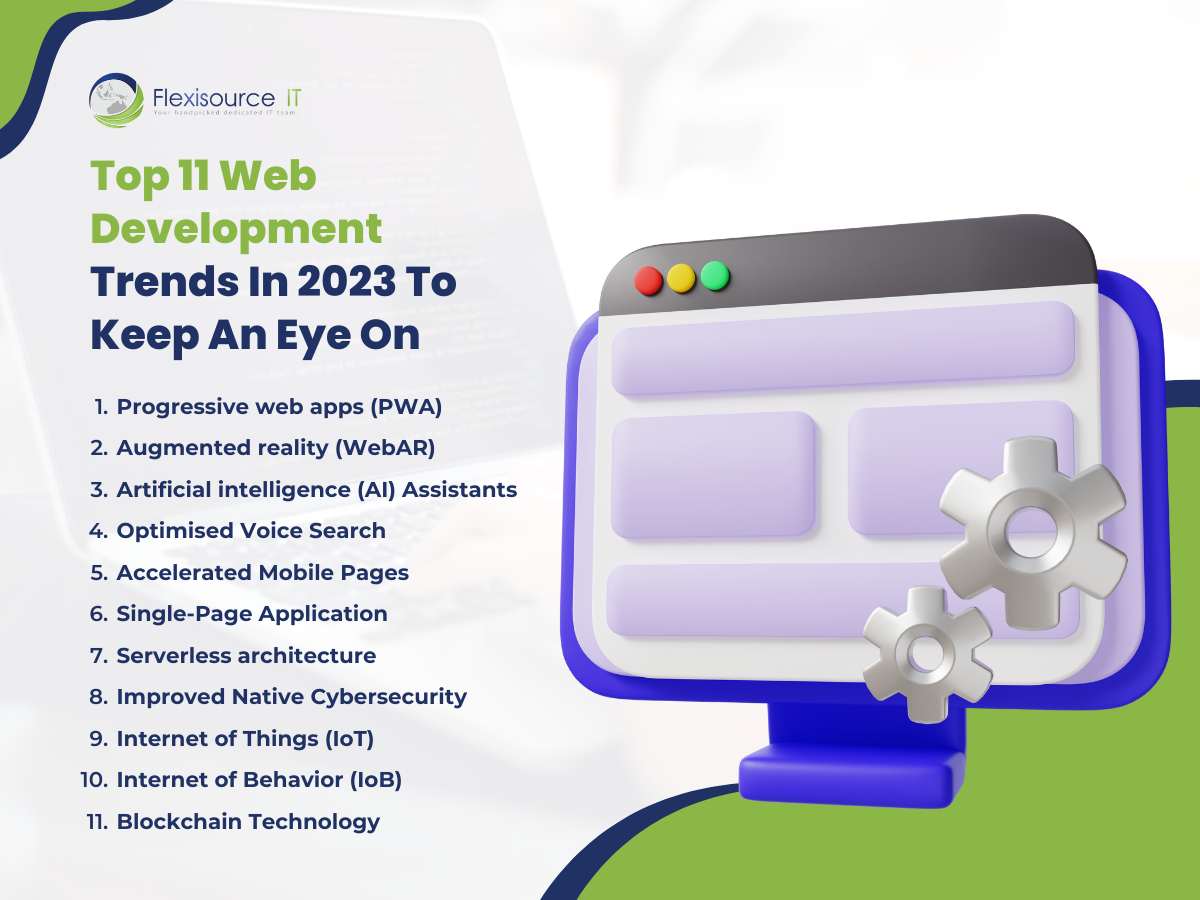There are so many exciting web development trends in 2023. These emerging technologies provide plenty of opportunities to set up your website, engage with users in different ways, and even stay ahead of your competition.
With the fast-paced change we are witnessing right now, it can be hard to keep up. Luckily, we listed the latest web development trends and web tools you should pay close attention to this year.

Top 11 Web Development Trends In 2023 To Keep An Eye On
Progressive web apps (PWA)
PWA is a type of web application that provides web users with an almost full native mobile app experience. In short, it functions as an app but is a website.
It is one of the front-end web development trends that web developers should keep an eye on. In fact, in 2020, decision-makers of e-commerce brands in Europe and the US were planning to invest in PWA.
Now, a lot of e-commerce companies have already started using PWA. Some well-known brands are also using them, such as Lyft, a ride-sharing platform, and Starbucks, one of the largest coffee house chains in the world.
Given the advantages that PWA can provide for companies, it is unsurprising that they are implementing it.
- Uses fewer data and operates in slower networks
- Easier to update
- Cost-efficient since it functions on any operating system which makes it easier to develop and maintain
- App-like user interface (UI)
- Safe since it can only be accessed through HTTPS sites
- Accessible on the web and app stores
Augmented Reality (WebAR)
Augmented reality is a technology that has been around for quite a while. In the past couple of years, we have seen new applications of this particular trend broaden as well. Until recently, we saw it in education, healthcare, and gaming.
WebAR is fast becoming one of the e-commerce web development trends to watch. Its interactive capabilities lead to a 94% higher conversion rate. While implementation can be challenging, this can be a big boon for e-commerce brands.
Here is something to consider: Back in 2021, its market size was estimated to be around 9 billion USD. In a recent report, it will grow to USD 100 billion by 2026.
This indicates that WebAR’s applications will further broaden in the following years as we enter Web3. But businesses do not have to wait that long. Big brands like Amazon, Sephora, and IKEA have already jumped on this trend.
In short, WebAR is an investment that is worth considering.
- No need to download and install a mobile application.
- No need for additional hardware or software.
- Can be used across different operating systems with just a Web browser.
- Easily access WebAR content through a hyperlink or a QR code.
- Track customer engagement metrics through robust Web analytics.
- Can easily outsource for web developers to implement WebAR app development and other creative services like 3D modelling.
Artificial Intelligence (AI) Assistants
In the past couple of months, there has been plenty of buzz around AI. Even so, it can potentially be one of the biggest web development trends that enhances the user experience.
By integrating AI assistants into a website, businesses can provide more personalised and interactive experiences for web visitors. As a result, this leads to higher engagement and customer satisfaction.
AI assistants can significantly lower customer complaints by 15%. Consequently, this can ultimately lead to increased sales.
Recently, 58% of B2B companies have already implemented AI-powered chatbots on their websites. Close behind them are 42% of B2C companies. The majority of these businesses invested in this trend because of its ability to provide 24-hour service and quick response times.
With that said, implementing AI-powered assistants for customer-related functions on a website provides plenty of benefits, including:
- Cut costs and boost revenue
- Provide a universal experience
- Increase customer loyalty
- Boost overall efficiency
- Provide convenience for customers
Optimised Voice Search
Since its introduction in 2011, voice search has become a popular tool for a lot of people, especially mobile device users. It is so widely used that it is projected to grow by USD 11.2 billion by 2026.
For businesses, one thing to take note of is that voice-assisted searches are equal for both the male and female populations. In the US alone, 72% of consumers engage with voice search through digital assistants like Siri, Google Assistant, Alexa, and Cortana.
In addition, optimising a website for voice search can yield plenty of benefits.
- Increase organic website traffic
- Build brand awareness & visibility
- Increase footfall for local searches
Accelerated Mobile Pages (AMP)
Page speed can impact whether or not people decide to buy. In fact, in a 2019 report, almost 70% of consumers base their willingness to make a purchase on a website’s page speed alone.
Since its initial launch in 2015, AMP has been providing mobile web users with lightning-fast digital experiences. While there has been a downtrend in its usage in recent years, it still makes up more than 34% of mobile usage for the entire internet.
While Google has explicitly stated that AMP pages are not being prioritised, a quick search on a mobile device will show that they are indeed ranking higher in the search results. In addition, it also provides a couple of benefits:
- Faster page load times
- Improved user experience
- Reduced data usage
- Easy implementation
- Enhanced security
Single-Page Application (SPA)
When it comes to web development trends, Javascript-based SPAs are the most recent and most popular right now. In fact, a lot of web users visit SPA applications already, like Facebook, Twitter, Netflix, Trello, Gmail, and a few more Google applications.
Not surprising, since its overall performance is comparably better to some others and it works quite well on any device. In addition, it also provides a couple of benefits that make it a popular choice for businesses and web developers.
- Loads faster than traditional websites
- Provides a great user experience
- Takes less time to build
- Makes it easy to debug
- Works and performs well even offline or with lower bandwidth.
Serverless Architecture
Also known as serverless computing, it is a fairly recent innovation that has become a hot topic in the world of web development, and for good reason. It runs on cloud technology.
It enables businesses and web developers to run any application or backend service without the need for administration. That means, provisioning, managing, or upgrading servers is no longer necessary.
This alone is a big boon. So much so, that tech giants like Amazon, Google, and Microsoft have already jumped on this trend and are even providing it. With the serverless architecture’s continued popularity, it is projected to reach a market size of USD 36.84 billion by 2028.
For businesses, serverless architecture can bring plenty of benefits.
- Scalable
- Faster time-to-market window
- Cost-effective
- Easy to maintain
Improved Native Cybersecurity
Cybersecurity has been an ongoing concern in the past couple of years—and more so now.
Just recently, the social media giant, Facebook, experienced a data breach that resulted in the personal data leak of more than 500 million people. And days later, LinkedIn was also subject to a breach that resulted in the leak of more than 500 million profiles. To add salt to a fresh wound, the hackers are selling the information online and even sharing 2 million records as proof.
With an alarming increase in crimes of this nature, companies have stepped up their native cybersecurity capabilities to minimise the chances of data breaches and potential losses. In fact, there is already a shift to application-based security measures like Google Authenticator, patch management, and security operation centres (SOCs).
Internet of Things (IoT)
IoT refers to the network of physical devices, appliances, and every other item that is embedded with sensors, software, and connectivity capabilities. This enables gadgets and appliances to connect and exchange data over the internet.
Now, IoT-enabled devices are in constant communication and transferring data. For businesses, this creates an opportunity to engage with more users and provide a personalised experience. An example of this would be smart home devices like Google Nest smart speakers.
With that said, this trend is worth considering since the products of IoT-connected devices are forecasted to grow to more than USD 29 billion in 2030. In addition, businesses also reap the following benefits:
- Handle large amounts of data efficiently.
- Reduce delays and errors in data collection and delivery.
- Enables websites to provide more customized experiences for web users.
- Automate tasks and streamline processes.
- Improve data security for both the business and users.
Internet of Behavior (IoB)
With that said, IoB is like the upgraded version of IoT. Instead of just connecting devices and transmitting data, IoB takes it a step further and allows devices to collect data about people and their behaviour.
While IoT-connected devices still have plenty of potential, the IoB devices market size was already valued at USD 391.5 billion back in 2021. In addition, it is forecasted that it will further grow to around USD 2,143.57 billion by 2030. This shows a compound annual growth rate (CAGR) of 20.79% from 2022 to 2030.
Moreover, it also provides a list of benefits for businesses:
- Better understanding and anticipating web user behaviour.
- Provides valuable data insights.
- Enhances personalisation and customisation of products and services.
- Allows for real-time monitoring and response to user behaviour.
Blockchain technology
It is worth noting that blockchain technology is considered one of the top web development trends today. It is an innovation that has been around for quite some time now, but its applications for website development are growing as we enter the third version of the internet.
Blockchain technology allows for a two-sided transaction event. Every transaction is verified by a decentralised distributed network, providing both businesses and consumers with accurate, correct, and verified data.
A lot of businesses see and understand the potential of blockchain technology. In fact, 96% of financial services pioneers believe that it has already been adopted on a mainstream level. It will continue to become an integral part of website development and even business systems, as it has a projected growth rate of 85.9% from 2022 to 2030.
This is with good reason too, considering the advantages that businesses and web users are poised to benefit from blockchain technology:
- Decentralization
- Security and immutability
- Transparency
- Efficiency and cost-effectiveness
- Trust and reliability
- Smart contracts
- Faster transactions
- Improved record-keeping
- Elimination of intermediaries
- Increased accountability
Keep Up To Trend
Trends are constantly evolving as technology advances and user preferences change. In addition, other important enterprise web development trends are shaping the industry.
That is why it is important to keep up with the latest news and trends in technology. These offer numerous benefits and opportunities for your business. Moreover, it is important to apply these trends when applicable to ensure your website is optimised and provides the best experience for your web visitors.
Want to learn more about web development? Discuss with Flexisource IT’s experts! Contact us today!











